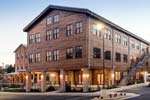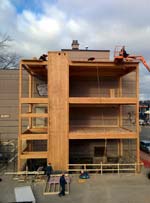
|

|
|
Home Site Search Contact Us Subscribe
|
|
CLT: A More Efficient, Cost Effective Design Partner for Sustainable Buildings Using cross-laminated timber in place of the old standards like steel and concrete is one way to reduce the environmental impact of a structure without compromising on the advances we've made in modern structural integrity. By Casey Malmquist August 23, 2017 Designing and specifying eco-friendly buildings has been the norm in our industry for well over a generation now. What’s amazing to me is how the innovations that continue to drive this practice forward are unceasing, and offer a broad horizon to design towards. While those innovations bring new choices to the fore, it’s important to remember that some building materials stand the test of time and hold up to newer sustainability measures just as well as (if not better) than other products available.
One good example of this is cross-laminated timber (CLT), an engineered wood building system that has widespread adoption in Europe. CLT is made from several layers of dimensional lumber, stacked crosswise and glued together. This provides dimensional stability, strength, and rigidity, making the product a viable alternative to concrete, masonry, and steel in many applications.
Compared to more conventional structural building components, CLT has a smaller carbon footprint and requires far less energy to produce. Concrete production alone represents roughly 5% of world carbon dioxide emissions, the dominant greenhouse gas. Weighted with data from the U.S. Green Building Council that 40% of U.S. CO2 emissions come from buildings, it is more than clear that an alternative building material can make a meaningful impact.
Leveraging the natural features found in wood, CLT offers numerous benefits to any sustainable design:
• Passive House/NetZero. Wood has the advantage of low thermal conductivity compared to steel and concrete. As a result, wood buildings are easy to insulate to high standards. CLT achieves a tight building envelope. This makes wood a good choice for designers who want to meet Passive House standards or create a net zero energy or net zero carbon building.
• Concrete has high carbon footprint. Materials such as masonry, concrete, and steel have a large carbon footprint and are extremely energy-intensive to produce. Finding materials that are better with a lower carbon footprint is important. Concrete production alone represents about 5% of global carbon dioxide emissions.
• Replacing concrete and steel with wood can have a significant impact on greenhouse gas emissions. For example, SmartLam’s projected annual production rate of 48 million board feet represents 77,841 metric tons of stored carbon. This is like removing more than 20,000 cars from the roadways each year.
• Wood is the only building material with third-party certification programs to verify that product originates from sustainably managed resources. My company, SmartLam, procures all of its lumber from companies practicing certified sustainable forestry (FSC, SFI, ATFS, and the Canadian Standards Association’s Sustainable Forest Management Standard).
The natural durability and beauty of CLT makes it a perfect partner for flexibility, faster project timelines, and reduced material costs:
A Converted Mill’s Flexibility and Efficiency of Design Star Mill, a former flour mill in American Fork, Utah, built in 1888, has been reimagined, thanks to a marriage of technologies past with forward-looking innovations, creating a building for the next generation of commerce. Curtis Miner Architecture worked with GreerCo., the owner, to improve the building while preserving the past, capitalizing on its unique features to maintain character and inspire creativity.
That spirit is reflected in materials chosen for the revitalization, particularly with the use of CLT as the flooring and ceilings on the second and third floors of a new addition. The CLT panels worked so well, the team decided to expand the use of the product to include flooring systems on the landings of the spiral staircase inside one of the old grain elevators, as well as on the floating deck that spans the main building.
An Elevator Shaft that Speeds Construction Schedules 2nd Street Lofts, designed by Kenneth Huff and recently constructed in Whitefish, Montana, specified a CLT elevator shaft. If the construction team had used poured concrete for the shaft, they would have had to budget for a process involving 8-12 people, added equipment to form and cure the shaft – and a month’s time to construct and cure the shaft. Using a CLT shaft, prefabricated in a warehouse under controlled conditions, the entire structure was assembled on site in a few hours with just three people and a crane operator. Inspecting the shaft was completed during the framing inspection, instead of bringing an inspector in every eight feet of progress, as required with a poured shaft. The cost of a CLT shaft, compared to concrete, was in the neighborhood of 70% to 75%, representing a significant savings.
A Visual Crossroads for Revamped Mass Transit The new Amtrak Cascades Station in Tacoma, Washington, designed by VIA Architecture and scheduled to open this fall, stands literally at the crossroads of old and new, replacing an existing portion of the historic Freighthouse Square building. Its unique position is reflected in the station’s design: open and welcoming, with nods to the past such as wooden columns and terrazzo flooring, but also sliding and vertical lift doors to create an indoor/outdoor public space and support the area’s development as a vibrant transit hub. CLT was specified for a structural roof deck with an exposed underside. The 20-foot-high CLT ceiling is supported by exposed Douglas fir glulam beams to help give the space a warm, inviting feeling to travelers passing through.
CLT's unique and warm visual aesthetic, as well as competitive pricing, made this material integral to the design and construction of the station, which will be the first U.S. rail station to include CLT in its construction. The structural characteristics support the project’s aim for a lasting link in a redefined transit system serving the Tacoma area.
Using CLT in place of the old standards like steel and concrete is one way to reduce the environmental impact of a structure without compromising on the advances we’ve made in modern structural integrity. Adding sustainability without sacrificing budgets, schedules, or designs is yet another advantage of this old-yet-new-again innovation. CLT is gaining recognition, and it won’t be long before the product is accepted as a common building material that delivers uncommonly great results.
Casey Malmquist has served as president and general manager of SmartLam, since its launch in January 2012, and which has become a globally-recognized producer of Cross-Laminated Timber products. The zero-waste company transports its high-quality shavings and sawdust from manufacturing to nearby fiber companies, and others to be used as components for other engineered wood products. Additional wood waste from manufacturing is chipped and used to heat the facility with biomass heating systems.
|
(click on pictures to enlarge)  SmartLam American Fork, Utah: Star Mill's spiral staircase, built inside an old grain elevator of the former flour mill (1888), used cross-laminated timber panels placed within the flooring system.  SmartLam Exterior of the renovated and expanded Star Mill in American Fork, Utah.  SmartLam The first ever elevator shaft made of cross-laminated timber, being installed in the 2nd Street Lofts, Whitefish, Montana, proved to save time, money, and energy.  Kenneth Huff with Solus Architecture Rendering of the 2nd Street Lofts in Whitefish, Montana.  Image courtesy VIA Architecture The new Amtrak Cascades Station in Tacoma, Washington, is using CLT for a structural roof deck with an exposed underside. |
© 2017 ArchNewsNow.com